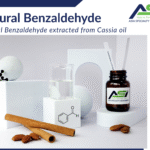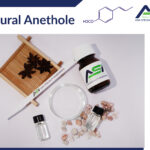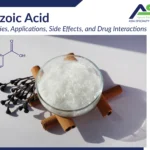Benzaldehyde is a widely used aromatic compound, best known for its characteristic almond-like scent. While it can be chemically synthesized, increasing consumer demand for natural and sustainable ingredients has sparked interest in plant-based sources. One such source is cassia oil, extracted from Cinnamomum cassia, which serves as an efficient natural precursor for producing benzaldehyde through fractional distillation or hydrolysis of natural cinnamaldehyde.
Table of Content
ToggleWhat is Natural Benzaldehyde?
Benzaldehyde (C₇H₆O) is the simplest aromatic aldehyde, consisting of a benzene ring with a formyl group. It is characterized by a distinct almond-like aroma and is widely used as a flavor and fragrance compound. Benzaldehyde naturally present in various plant sources, most notably in bitter almonds, cinnamon cassia, and certain fruits of the Rosaceae family. While benzaldehyde can be synthesized from petroleum-derived toluene, “natural benzaldehyde” is extracted from natural sources such as bitter almond oil, cassia oil, and others.
Physical properties:
– Appearance: Mobile, colourless to slightly yellow liquid
– Odor: Almond like
– Solubility: Soluble in ethanol, glycerin, propylene glycol, organic esters, ketones, essential oils
– Refractive index (20°C): 1.5400 – 1.5480
– Specific gravity (20°C): 1.041 – 1.051
– Boiling Point: 178 °C

Figure 1: Natural benzaldehyde extracted from Cassia oil
History:
In 1803, French pharmacist Martrès successfully isolated benzaldehyde from bitter almonds. Nearly thirty years later, in 1832, German chemists Friedrich Wöhler and Justus von Liebig carried out the first successfully synthesis of benzaldehyde, laying foundational work for the structural theory of organic chemistry.
Natural Benzaldehyde from Cassia Oil
Cassia (Cinnamomum cassia) is primarily cultivated in Vietnam and southern China. It is valued not only for its essential oil but also as a strategic crop for producing natural benzaldehyde. In Vietnam, the cassia plantation area reaches approximately 200,000 hectares. The main growing region is in Lao Cai province, with the annual production of cassia essential oil being about 1,500 to 2,000 metric tons. This makes Vietnam one of the leading producers of cassia essential oil in the world. Cassia oil contains cinnamaldehyde as its major component (78–90%) and a smaller amount of benzaldehyde (~1–3%).
Currently, there are two common commercial methods for producing natural benzaldehyde. These are fractional distillations from cassia oil and hydrolysis from natural cinnamaldehyde.
The fractional distillation method complies with European Union regulations. According to Regulation (EC) No 1334/2008, a natural flavoring substance is one obtained through appropriate physical, enzymatic, or microbiological processes. These processes use material of vegetable, animal, or microbiological origin, either in its raw state or after processing for human consumption through traditional food preparation methods. Fractional distillation is considered a physical process meeting these criteria. While benzaldehyde in cassia can be easily separated through fractional distillation, its relatively low natural content in cassia oil leads to low recovery yields and high raw material costs.
For the United States market, the hydrolysis method is more commonly used. This follows the Code of Federal Regulations, Section 21 CFR 101.22. It defines natural flavor or natural flavoring as including essential oils, oleoresins, essences or extractives, protein hydrolysates, distillates, or any product of roasting, heating, or enzymolysis. The hydrolysis process falls under the “product of heating” or “distillates” categories, allowing the resulting benzaldehyde to be classified as natural for the US market. The hydrolysis process of cinnamaldehyde from cassia oil can achieve higher conversion yields compared to direct distillation from crude essential oil because cinnamaldehyde is a more abundant component in cassia oil.
The quality and purity of natural benzaldehyde obtained from cassia essential oil are key factors determining its applicability in food, pharmaceuticals, and cosmetics. Natural benzaldehyde obtained from cassia essential oil has high purity (Min 98.0%) and is tested using gas chromatography (GC) or GC-MS methods to identify residual impurities in order to determine the purity of the product.
Compared to other raw materials such as bitter almonds, cassia is considered fractional distillation a more economical and sustainable option, ensuring a stable supply, retaining the natural aroma, and meeting traceability requirements.
Applications of Natural Benzaldehyde
Food and Flavoring
In the food and beverage industry, benzaldehyde is a commonly used flavoring agent that imparts a characteristic almond aroma to products such as baked goods, soft candy, non-alcoholic beverages, alcoholic beverages, and chewing gum. Thanks to its easily recognizable natural flavor, benzaldehyde is especially suitable for products targeting consumers who prefer naturally sourced ingredients.
In the United States, benzaldehyde is classified as GRAS (Generally Recognized As Safe) by the Food and Drug Administration (FDA) and is approved by the Flavor and Extract Manufacturers Association (FEMA) with FEMA number 2127 for use as a food flavoring.
Regarding consumption safety, JECFA – the Joint FAO/WHO Expert Committee on Food Additives – has established a group ADI (acceptable daily intake) for benzaldehyde at 0–5 mg/kg body weight per day. Meanwhile, the U.S. Environmental Protection Agency (EPA) has set a reference dose (RfD) for benzaldehyde at 0.1 mg/kg/day.
Current usage levels of benzaldehyde in food are typically very low, only at the ppm level, which is below the established safety thresholds. Therefore, the use of naturally sourced benzaldehyde from cassia essential oil not only ensures regulatory compliance and consumer safety but also meets the growing demand for natural and sustainable flavoring ingredients.
Pharmaceutical
In the pharmaceutical field, benzaldehyde is effective in the synthesis of drugs and other pharmaceutical intermediates. It is utilized in the production of medicines, such as antibiotics and cardiovascular drugs.
In addition, benzaldehyde has been studied as a supporting substance for absorption. When combined with certain active ingredients with low bioavailability, such as acyclovir or hydrochlorothiazide, in mouse models, absorption indicators such as Cₘₐₓ and AUC increased significantly. This opens a new research direction for incorporating benzaldehyde as a supporting substance for enhancing absorption in pharmaceutical formulations (Wen et al., 2021).
Cosmetic
Natural benzaldehyde is a plant-derived fragrance ingredient that is commonly used in cosmetics due to its characteristic almond-like aroma. This ingredient is often found in products such as skin creams, lip balms, perfumes, and natural personal care items. Within the clean beauty trend, natural benzaldehyde is favored because it meets the requirement for natural origin and contributes to a sense of safety for consumers.
In terms of safety, benzaldehyde has been reviewed and approved for cosmetic use by organizations including the Cosmetic Ingredient Review (CIR) and the International Fragrance Association (IFRA). According to IFRA, the maximum approved concentration of benzaldehyde in finished products is 0.27 percent for face/body products applied with fingertips, 0.014 percent for products used on the axillae, and 0.045 percent for products used on the lips. These usage levels ensure that natural benzaldehyde can be safely used while still offering its aromatic benefits in a wide range of personal care applications.
Agrochemicals
Natural benzaldehyde, with its biological activity, is being considered as a potential ingredient for the development of pesticides for use in agriculture. It has effects on herbicide resistance, plant growth regulation, and amine resistance. In addition, some studies have recorded that benzaldehyde has the ability to inhibit important enzymes and possesses excellent antioxidant activity, making it a notable compound in sustainable pest control strategies.
Chemical Synthesis and Industrial Applications
Benzaldehyde is a key starting material in the synthesis of various chemicals, including: Dyes, Flavor and fragrance compounds, Pharmaceutical intermediates, Plastic additives,…
In these applications, benzaldehyde’s reactivity as an aldehyde and the stability of its aromatic ring make it a valuable compound in organic synthesis.
Market Trends of Natural Benzaldehyde
The natural benzaldehyde market is witnessing steady growth as global consumers increasingly prioritize products that are naturally sourced and environmentally friendly. According to a report by Market Research Intellect (2025), the natural benzaldehyde market reached 220 million US dollars in 2024 and is expected to increase to 350 million US dollars by 2033. This expansion corresponds to a compound annual growth rate of 6.5 percent for the period from 2026 to 2033.
Global consumer trends are also contributing to this increasing demand. According to a report by Ingredion (2023), up to 78% of consumers are willing to pay more despite inflation for natural and clean-label products. This creates a foundation for brands in the food, cosmetics, and pharmaceutical sectors to incorporate naturally sourced ingredients in their formulations and prioritize raw materials with clear origin and environmental friendliness, including natural benzaldehyde.
Vietnam, with its large cinnamon cultivation area and growing investment in extraction technology, is considered a stable supplier of natural benzaldehyde to the global market. In the context of increasing preference for natural and traceable ingredients, the role of Vietnamese manufacturers is expected to continue to grow in the global supply chain.
Conclusion
Natural benzaldehyde from Vietnam’s cassia oil has a high-quality, safe ingredient and offers a sustainable alternative to synthetic versions. As consumer demand continues to shift toward natural and environmentally responsible ingredients, natural benzaldehyde from cassia oil stands out as a strategic choice for manufacturers seeking quality, safety, and sustainability.
Asia Specialty Ingredients (ASI), part of Asia Ingredients Group (AIG), specializes in the production and global export of essential oils and natural aromatics. Our range of products is meticulously processed using only the finest natural ingredients sourced from the typical lands of Vietnam, including Cassia, Basil, Star Anise, Litsea Cubeba and more, ensuring good product quality. Contact us for more collaboration opportunity!
References
- World Health Organization (WHO). (2001). Benzaldehyde. Evaluations of the Joint FAO/WHO Expert Committee on Food Additives (JECFA). Retrieved from https://apps.who.int/food-additives-contaminants-jecfa-database/Home/Chemical/4726
- S. Environmental Protection Agency. (1988). Benzaldehyde (CASRN 100‑52‑7): Integrated risk information system (IRIS) summary. National Center for Environmental Assessment. Retrieved from https://iris.epa.gov/static/pdfs/0332_summary.pdf
- Wen, W., Luo, J., Li, P., Huang, W., Wang, P., & Xu, S. (2021). Benzaldehyde, a new absorption promoter, accelerating absorption on low bioavailability drugs through membrane permeability. Frontiers in Pharmacology, 12, 663743. https://doi.org/10.3389/fphar.2021.663743
- Cosmetic Ingredient Review Expert Panel. (2006). Safety assessment of benzaldehyde as used in cosmetics. CIR. Retrieved from https://www.cir-safety.org/sites/default/files/Benzaldehyde.pdf
- Ullah, I., Khan, A. L., Ali, L., Khan, A. R., Waqas, M., Hussain, J., Lee, I.-J., & Shin, J.-H. (2015). Benzaldehyde as an insecticidal, antimicrobial, and antioxidant compound produced by Photorhabdus temperata M1021. Journal of Microbiology, 53(2), 127–133. https://doi.org/10.1007/s12275-015-4632-4
- Crawford, E. (2023, February 21). Ingredion: 78% of consumers will pay more for clean‑label, natural claims despite inflation. FoodNavigator‑ https://www.foodnavigator-usa.com/Article/2023/02/21/ingredion-78-of-consumers-will-pay-more-for-clean-label-natural-claims-despite-inflation/
- https://chemcess.com/benzaldehyde-production-reactions-and-uses/
- https://material-properties.org/benzaldehyde/
- BENZALDEHYDE | Ataman Chemicals
- Market Research Intellect. (2025, June). Comprehensive Analysis of Natural Benzaldehyde Market – Trends, Forecast, and Regional Insights [Report ID: 929374]. https://www.marketresearchintellect.com/product/global-natural-benzaldehyde-market/








